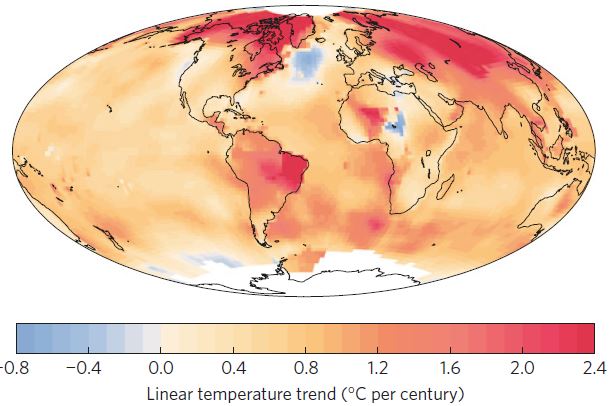Research article22 Mar 2016
Ice melt, sea level rise and superstorms: evidence from paleoclimate data, climate modeling, and modern observations that 2 °C global warming could be dangerous
James Hansen1, Makiko Sato1, Paul Hearty2, Reto Ruedy3,4, Maxwell Kelley3,4, Valerie Masson-Delmotte5, Gary Russell4, George Tselioudis4, Junji Cao6, Eric Rignot7,8, Isabella Velicogna7,8, Blair Tormey9, Bailey Donovan10, Evgeniya Kandiano11, Karina von Schuckmann12, Pushker Kharecha1,4, Allegra N. Legrande4, Michael Bauer4,13, and Kwok-Wai Lo3,4
1Climate Science, Awareness and Solutions, Columbia University Earth Institute, New York, NY 10115, USA
2Department of Environmental Studies, University of North Carolina at Wilmington, NC 28403, USA
3Trinnovium LLC, New York, NY 10025, USA
4NASA Goddard Institute for Space Studies, 2880 Broadway, New York, NY 10025, USA
5Institut Pierre Simon Laplace, Laboratoire des Sciences du Climat et de l'Environnement (CEA-CNRS-UVSQ), Gif-sur-Yvette, France
6Key Lab of Aerosol Chemistry & Physics, Institute of Earth Environment, Chinese Academy of Sciences, Xi'an 710075, China
7Jet Propulsion Laboratory, California Institute of Technology, Pasadena, CA 91109, USA
8Department of Earth System Science, University of California, Irvine, CA 92697, USA
9Program for the Study of Developed Shorelines, Western Carolina University, Cullowhee, NC 28723, USA
10Department of Geological Sciences, East Carolina University, Greenville, NC 27858, USA
11GEOMAR, Helmholtz Centre for Ocean Research, Wischhofstrasse 1–3, Kiel 24148, Germany
12Mediterranean Institute of Oceanography, University of Toulon, La Garde, France
13Department of Applied Physics and Applied Mathematics, Columbia University, New York, NY 10027, USA
Received: 11 Jun 2015 – Published in Atmos. Chem. Phys. Discuss.: 23 Jul 2015
Revised: 17 Feb 2016 – Accepted: 18 Feb 2016 – Published: 22 Mar 2016
Abstract. We use numerical climate simulations, paleoclimate data, and modern observations to study the effect of growing ice melt from Antarctica and Greenland. Meltwater tends to stabilize the ocean column, inducing amplifying feedbacks that increase subsurface ocean warming and ice shelf melting. Cold meltwater and induced dynamical effects cause ocean surface cooling in the Southern Ocean and North Atlantic, thus increasing Earth's energy imbalance and heat flux into most of the global ocean's surface. Southern Ocean surface cooling, while lower latitudes are warming, increases precipitation on the Southern Ocean, increasing ocean stratification, slowing deepwater formation, and increasing ice sheet mass loss. These feedbacks make ice sheets in contact with the ocean vulnerable to accelerating disintegration. We hypothesize that ice mass loss from the most vulnerable ice, sufficient to raise sea level several meters, is better approximated as exponential than by a more linear response. Doubling times of 10, 20 or 40 years yield multi-meter sea level rise in about 50, 100 or 200 years. Recent ice melt doubling times are near the lower end of the 10–40-year range, but the record is too short to confirm the nature of the response. The feedbacks, including subsurface ocean warming, help explain paleoclimate data and point to a dominant Southern Ocean role in controlling atmospheric CO2, which in turn exercised tight control on global temperature and sea level. The millennial (500–2000-year) timescale of deep-ocean ventilation affects the timescale for natural CO2 change and thus the timescale for paleo-global climate, ice sheet, and sea level changes, but this paleo-millennial timescale should not be misinterpreted as the timescale for ice sheet response to a rapid, large, human-made climate forcing. These climate feedbacks aid interpretation of events late in the prior interglacial, when sea level rose to +6–9 m with evidence of extreme storms while Earth was less than 1 °C warmer than today. Ice melt cooling of the North Atlantic and Southern oceans increases atmospheric temperature gradients, eddy kinetic energy and baroclinicity, thus driving more powerful storms. The modeling, paleoclimate evidence, and ongoing observations together imply that 2 °C global warming above the preindustrial level could be dangerous. Continued high fossil fuel emissions this century are predicted to yield (1) cooling of the Southern Ocean, especially in the Western Hemisphere; (2) slowing of the Southern Ocean overturning circulation, warming of the ice shelves, and growing ice sheet mass loss; (3) slowdown and eventual shutdown of the Atlantic overturning circulation with cooling of the North Atlantic region; (4) increasingly powerful storms; and (5) nonlinearly growing sea level rise, reaching several meters over a timescale of 50–150 years. These predictions, especially the cooling in the Southern Ocean and North Atlantic with markedly reduced warming or even cooling in Europe, differ fundamentally from existing climate change assessments. We discuss observations and modeling studies needed to refute or clarify these assertions.
Citation: Hansen, J., Sato, M., Hearty, P., Ruedy, R., Kelley, M., Masson-Delmotte, V., Russell, G., Tselioudis, G., Cao, J., Rignot, E., Velicogna, I., Tormey, B., Donovan, B., Kandiano, E., von Schuckmann, K., Kharecha, P., Legrande, A. N., Bauer, M., and Lo, K.-W.: Ice melt, sea level rise and superstorms: evidence from paleoclimate data, climate modeling, and modern observations that 2 °C global warming could be dangerous, Atmos. Chem. Phys., 16, 3761-3812, doi:10.5194/acp-16-3761-2016, 2016.
http://www.atmos-chem-phys.net/16/3761/2016/
We are already in the midst of some of these projections....perhaps you can start by exploring the cold spot in the North Atlantic that has given rise to so many named storms for the UK. The implications of the cold spot are very concerning.
What’s going on in the North Atlantic?
Filed under: Climate Science — stefan @ 23 March 2015
The North Atlantic between Newfoundland and Ireland is practically the only region of the world that has defied global warming and even cooled. Last winter there even was the coldest on record – while globally it was the hottest on record. Our recent study (Rahmstorf et al. 2015) attributes this to a weakening of the Gulf Stream System, which is apparently unique in the last thousand years.
The whole world is warming. The whole world? No! A region in the subpolar Atlantic has cooled over the past century – unique in the world for an area with reasonable data coverage (Fig. 1). So what’s so special about this region between Newfoundland and Ireland?
more
http://www.realclimate.org/index.php/ar ... -atlantic/

